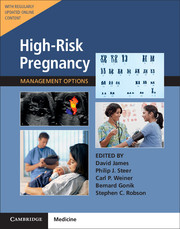Book contents
- Frontmatter
- Contents
- List of Contributors
- Preface
- Section 1 Prepregnancy Problems
- Section 2 Early Prenatal Problems
- Section 3 Late Prenatal – Fetal Problems
- Section 4 Problems Associated with Infection
- Section 5 Late Pregnancy – Maternal Problems
- 30 Substance Misuse in Pregnancy
- 31 Medication in Pregnancy
- 32 Hypertension in Pregnancy
- 33 Cardiac Disease in Pregnancy
- 34 Respiratory Disease in Pregnancy
- 35 Anemia and White Blood Cell Disorders in Pregnancy
- 36 Hematological Malignancies in Pregnancy
- 37 Thrombocytopenia and Bleeding Disorders in Pregnancy
- 38 Disorders of Coagulation in Pregnancy
- 39 Autoimmune Disease in Pregnancy
- 40 Diabetes in Pregnancy
- 41 Thyroid Disease in Pregnancy
- 42 Pituitary and Adrenal Disease in Pregnancy
- 43 Gastrointestinal and Liver Diseases in Pregnancy
- 44 Neurologic Complications in Pregnancy
- 45 Renal Disorders in Pregnancy
- 46 Spine and Joint Disorders in Pregnancy
- 47 Skin Disease in Pregnancy
- 48 Malignant Disease in Pregnancy
- 49 Pregnancy After Transplantation
- 50 Trauma in Pregnancy
- 51 Mental Health Disorders in Pregnancy
- Section 6 Late Prenatal – Obstetric Problems
- Section 7 Postnatal Problems
- Section 8 Normal Values
- Index
32 - Hypertension in Pregnancy
from Section 5 - Late Pregnancy – Maternal Problems
- Frontmatter
- Contents
- List of Contributors
- Preface
- Section 1 Prepregnancy Problems
- Section 2 Early Prenatal Problems
- Section 3 Late Prenatal – Fetal Problems
- Section 4 Problems Associated with Infection
- Section 5 Late Pregnancy – Maternal Problems
- 30 Substance Misuse in Pregnancy
- 31 Medication in Pregnancy
- 32 Hypertension in Pregnancy
- 33 Cardiac Disease in Pregnancy
- 34 Respiratory Disease in Pregnancy
- 35 Anemia and White Blood Cell Disorders in Pregnancy
- 36 Hematological Malignancies in Pregnancy
- 37 Thrombocytopenia and Bleeding Disorders in Pregnancy
- 38 Disorders of Coagulation in Pregnancy
- 39 Autoimmune Disease in Pregnancy
- 40 Diabetes in Pregnancy
- 41 Thyroid Disease in Pregnancy
- 42 Pituitary and Adrenal Disease in Pregnancy
- 43 Gastrointestinal and Liver Diseases in Pregnancy
- 44 Neurologic Complications in Pregnancy
- 45 Renal Disorders in Pregnancy
- 46 Spine and Joint Disorders in Pregnancy
- 47 Skin Disease in Pregnancy
- 48 Malignant Disease in Pregnancy
- 49 Pregnancy After Transplantation
- 50 Trauma in Pregnancy
- 51 Mental Health Disorders in Pregnancy
- Section 6 Late Prenatal – Obstetric Problems
- Section 7 Postnatal Problems
- Section 8 Normal Values
- Index
Summary
Introduction
The hypertensive disorders of pregnancy encompass a spectrum of conditions associated with high blood pressure, proteinuria, and, less commonly, multisystem disease during and for a short time after pregnancy. Gestational hypertension should resolve within 3 months postpartum. The disorders are common and every obstetrician is required to manage such patients on a regular basis. Their importance is highlighted by the association with significant maternal and perinatal morbidity and mortality worldwide.
The most recent United Kingdom and Ireland Confidential Enquiry into Maternal Deaths and Morbidity (Saving Lives, Improving Mothers’ Care) demonstrated preeclampsia and eclampsia to be responsible for nine maternal deaths during 2010–12 (rate 0.38 per 100,000 maternities): the fourth most common cause of direct maternal death after thromboembolic disease, genital tract sepsis, and hemorrhage. In high-income countries, the absolute rate of hypertensive disorders of pregnancy has been reported as 3.6–9.1%, and a declining trend has been noted.2 This decline, despite an increasing incidence of conditions such as obesity, chronic hypertension, diabetes, and advanced age for women entering pregnancy, may be due to changes in the classification of the disorders, but is more likely due to the use of interventions that decrease the risk and/or progression of hypertensive disease, such as elective early delivery. The perinatal risk in mothers with preeclampsia is evidenced by 1 in 20 (5%) of all UK stillbirths without congenital abnormality occurring in women with the disorder. One in 250 (0.4%) of all UK nullipara will give birth before 34 weeks’ gestation because of preeclampsia.
In low- and middle-income countries the absolute rates are certainly much higher and the impact of the disorders is greater, with significant morbidity and mortality for both mothers and babies. In these environments, many women present late with disease that is at an advanced stage and thus less amenable to medical intervention. In contrast to the UK and Ireland Confidential Enquiry, the Saving Mothers report from South Africa demonstrated hypertensive diseases to be responsible for 679 maternal deaths during 2008–10, representing 14.0% of all deaths and second only to obstetric hemorrhage in the direct deaths category.
This chapter will consider the classification of the hypertensive disorders and discuss the management of each in turn.
- Type
- Chapter
- Information
- High-Risk Pregnancy: Management OptionsFive-Year Institutional Subscription with Online Updates, pp. 847 - 899Publisher: Cambridge University PressFirst published in: 2017



